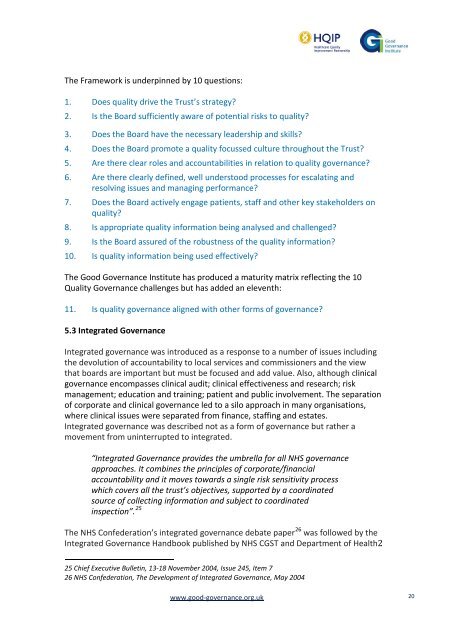Good Governance Handbook - HQIP
Good Governance Handbook - HQIP
Good Governance Handbook - HQIP
Create successful ePaper yourself
Turn your PDF publications into a flip-book with our unique Google optimized e-Paper software.
The Framework is underpinned by 10 questions:<br />
1. Does quality drive the Trust’s strategy?<br />
2. Is the Board sufficiently aware of potential risks to quality?<br />
3. Does the Board have the necessary leadership and skills?<br />
4. Does the Board promote a quality focussed culture throughout the Trust?<br />
5. Are there clear roles and accountabilities in relation to quality governance?<br />
6. Are there clearly defined, well understood processes for escalating and<br />
resolving issues and managing performance?<br />
7. Does the Board actively engage patients, staff and other key stakeholders on<br />
quality?<br />
8. Is appropriate quality information being analysed and challenged?<br />
9. Is the Board assured of the robustness of the quality information?<br />
10. Is quality information being used effectively?<br />
The <strong>Good</strong> <strong>Governance</strong> Institute has produced a maturity matrix reflecting the 10<br />
Quality <strong>Governance</strong> challenges but has added an eleventh:<br />
11. Is quality governance aligned with other forms of governance?<br />
5.3 Integrated <strong>Governance</strong><br />
Integrated governance was introduced as a response to a number of issues including<br />
the devolution of accountability to local services and commissioners and the view<br />
that boards are important but must be focused and add value. Also, although clinical<br />
governance encompasses clinical audit; clinical effectiveness and research; risk<br />
management; education and training; patient and public involvement. The separation<br />
of corporate and clinical governance led to a silo approach in many organisations,<br />
where clinical issues were separated from finance, staffing and estates.<br />
Integrated governance was described not as a form of governance but rather a<br />
movement from uninterrupted to integrated.<br />
“Integrated <strong>Governance</strong> provides the umbrella for all NHS governance<br />
approaches. It combines the principles of corporate/financial<br />
accountability and it moves towards a single risk sensitivity process<br />
which covers all the trust’s objectives, supported by a coordinated<br />
source of collecting information and subject to coordinated<br />
inspection”. 25<br />
The NHS Confederation’s integrated governance debate paper 26 was followed by the<br />
Integrated <strong>Governance</strong> <strong>Handbook</strong> published by NHS CGST and Department of Health2<br />
25 Chief Executive Bulletin, 13-18 November 2004, Issue 245, Item 7<br />
26 NHS Confederation, The Development of Integrated <strong>Governance</strong>, May 2004<br />
www.good-governance.org.uk 20

















